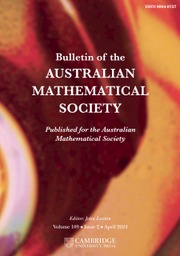Crossref Citations
This article has been cited by the following publications. This list is generated based on data provided by Crossref.
Aguirre, M.
and
Krause, J.
1988.
SL(3,R) as the group of symmetry transformations for all one-dimensional linear systems.
Journal of Mathematical Physics,
Vol. 29,
Issue. 1,
p.
9.
Feerrario, C
and
Passerini, A
1991.
Extended covariance for the Lagrange equations of motion: a geometric analysis.
Journal of Physics A: Mathematical and General,
Vol. 24,
Issue. 6,
p.
L261.
Aguirre, M.
Friedli, C.
and
Krause, J.
1992.
SL(3,R) as the group of symmetry transformations for all one-dimensional linear systems. III. Equivalent Lagrangian formalisms.
Journal of Mathematical Physics,
Vol. 33,
Issue. 5,
p.
1571.
Krause, J
1992.
Some remarks on the generalized Noether theory of point symmetry transformations of the Lagrangian.
Journal of Physics A: Mathematical and General,
Vol. 25,
Issue. 4,
p.
991.
Filippov, V. M.
Savchin, V. M.
and
Shorokhov, S. G.
1994.
Variational principles for nonpotential operators.
Journal of Mathematical Sciences,
Vol. 68,
Issue. 3,
p.
275.
de León, Manuel
and
de Diego, David Martin
1994.
Nonautonomous submersive second-order differential equations and lie symmetries.
International Journal of Theoretical Physics,
Vol. 33,
Issue. 8,
p.
1759.
de León, Manuel
and
de Diego, David Martín
1995.
Symmetries and constants of the motion for higher-order Lagrangian systems.
Journal of Mathematical Physics,
Vol. 36,
Issue. 8,
p.
4138.
de Léon, Manuel
and
Martín de Diego, David
1996.
Symmetries and constants of the motion for singular Lagrangian systems.
International Journal of Theoretical Physics,
Vol. 35,
Issue. 5,
p.
975.
Martínez, Sonia
Cortés, Jorge
and
de León, Manuel
2001.
Symmetries in vakonomic dynamics: applications to optimal control.
Journal of Geometry and Physics,
Vol. 38,
Issue. 3-4,
p.
343.
Jerie, M.
and
Prince, G.E.
2002.
Jacobi fields and linear connections for arbitrary second-order ODEs.
Journal of Geometry and Physics,
Vol. 43,
Issue. 4,
p.
351.
Krupka, Demeter
Krupková, Olga
Prince, Geoff
and
Sarlet, Willy
2007.
Contact symmetries of the Helmholtz form.
Differential Geometry and its Applications,
Vol. 25,
Issue. 5,
p.
518.
Krupková, O.
and
Prince, G.E.
2008.
Handbook of Global Analysis.
p.
837.
Popescu, Liviu
2017.
Symmetries of second order differential equations on Lie algebroids.
Journal of Geometry and Physics,
Vol. 117,
Issue. ,
p.
84.
de León, Manuel
and
Lainz Valcázar, Manuel
2020.
Infinitesimal symmetries in contact Hamiltonian systems.
Journal of Geometry and Physics,
Vol. 153,
Issue. ,
p.
103651.
Popescu, Liviu
2020.
Symmetries and conservation laws of Hamiltonian systems.
Journal of Geometry and Physics,
Vol. 151,
Issue. ,
p.
103638.
Попеску, Л.
and
Popescu, L.
2020.
Симметрии гамильтоновых систем на алгеброидах Ли.
Итоги науки и техники. Серия «Современная математика и ее приложения. Тематические обзоры»,
Vol. 178,
Issue. ,
p.
112.
Speliotopoulos, Achilles D
2020.
Constrained dynamics: generalized Lie symmetries, singular Lagrangians, and the passage to Hamiltonian mechanics.
Journal of Physics Communications,
Vol. 4,
Issue. 6,
p.
065002.
de León, Manuel
Lainz, Manuel
and
López-Gordón, Asier
2021.
Symmetries, constants of the motion, and reduction of mechanical systems with external forces.
Journal of Mathematical Physics,
Vol. 62,
Issue. 4,
Speliotopoulos, Achilles D
2023.
Generalized Lie symmetries and almost regular Lagrangians: a link between symmetry and dynamics.
Journal of Physics Communications,
Vol. 7,
Issue. 1,
p.
015001.
Popescu, L.
2023.
Symmetries of Hamiltonian Systems on Lie Algebroids.
Journal of Mathematical Sciences,
Vol. 276,
Issue. 2,
p.
310.

